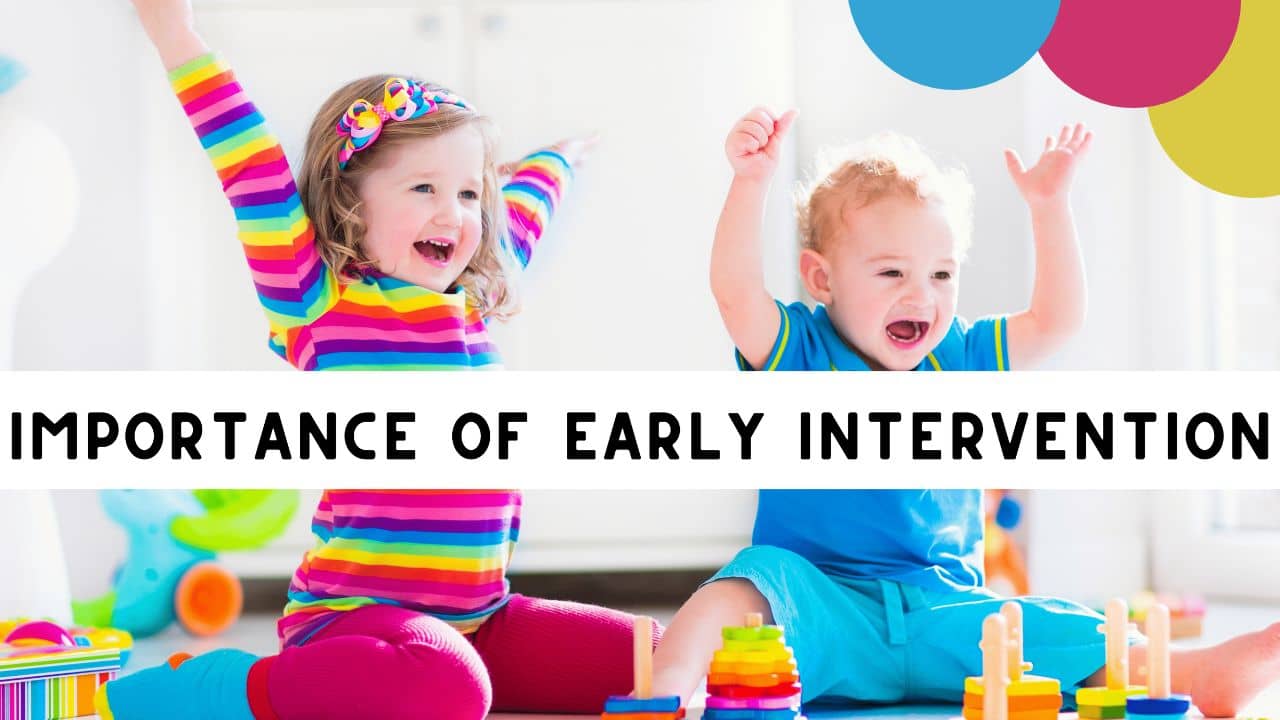Early intervention in autism refers to the provision of specialized support, services, and therapies to children with autism spectrum disorder (ASD) as early as possible, ideally during their early developmental years. The goal of early intervention is to promote positive developmental outcomes and enhance the child’s overall functioning and quality of life.
Key aspects of early intervention in autism include:
1. Importance of Early Detection of Autism

Early detection of autism is crucial for timely intervention and support for individuals with the condition. Autism spectrum disorder (ASD) is a neurodevelopmental disorder characterized by difficulties in social communication and interaction, as well as restricted and repetitive behaviors.
Early detection allows for early intervention, which can have a significant impact on a child’s developmental trajectory. Interventions at a young age can help improve communication, social skills, and adaptive behaviors, leading to better long-term outcomes.
The signs of autism can manifest in early childhood, often becoming noticeable around the age of 2-3 years. These signs may include a lack of interest in social interactions, difficulties in understanding and using language, repetitive behaviors, sensory sensitivities, and a preference for routines.
Pediatricians and healthcare providers use standardized developmental screening tools to identify children at risk for autism. Examples of such tools include the Modified Checklist for Autism in Toddlers (M-CHAT) and the Social Communication Questionnaire (SCQ). If a child is identified as at risk, further comprehensive assessments are conducted by specialists, such as developmental pediatricians, psychologists, or speech therapists, to determine if the child meets the criteria for an autism diagnosis.
If a child is diagnosed with autism, early intervention services can be tailored to their specific needs. These services may include speech therapy, occupational therapy, behavioral therapy (such as Applied Behavior Analysis), social skills training, and parent training programs. Early intervention focuses on addressing the core deficits of autism and promoting developmental progress.
2. Individualized Assessment of Autism:

Individualized assessment of autism involves a comprehensive and tailored approach to evaluating the strengths, challenges, and specific needs of a person suspected of having autism spectrum disorder (ASD). This assessment aims to provide a detailed understanding of the individual’s profile, which can guide intervention strategies, educational planning, and support services.
Here’s an overview of the process:
- Multidisciplinary Team: An individualized assessment typically involves a team of professionals from various disciplines, such as developmental pediatrics, psychology, speech and language therapy, occupational therapy, and education. This team collaborates to gather a holistic view of the individual’s functioning.
- Parent/Caregiver Input: Parents or caregivers are an integral part of the assessment process. They provide valuable information about the individual’s developmental history, behaviors, strengths, challenges, and any concerns they may have noticed. This input helps in building a comprehensive picture of the individual’s development.
- Observational Assessment: Professionals observe the individual in various settings, such as clinical environments, homes, schools, or community settings. These observations help in assessing social interactions, communication skills, behavior patterns, sensory sensitivities, and adaptive functioning.
- Interviews: Structured interviews with parents or caregivers, as well as self-report interviews with older individuals, are conducted to gather information about developmental milestones, early behaviors, challenges, and any other relevant factors.
- Standardized Assessments: Various standardized assessment tools are used to measure specific areas of functioning. These can include assessments of communication skills, social interaction, sensory processing, cognitive abilities, and adaptive behavior. Some commonly used tools include the Autism Diagnostic Observation Schedule (ADOS), the Autism Diagnostic Interview-Revised (ADI-R), and various cognitive and developmental assessments.
- Language and Communication Assessment: A thorough assessment of language development, both expressive and receptive, is conducted. This includes evaluating speech clarity, vocabulary, grammar, and the ability to initiate and maintain conversations.
- Social Interaction Assessment: The individual’s ability to engage in reciprocal social interactions, understand nonverbal cues, and show appropriate emotional responses is assessed.
- Behavioral Assessment: Behavioral assessments examine repetitive behaviors, special interests, sensory sensitivities, and other behaviors associated with autism. This helps in understanding the individual’s unique characteristics and challenges.
- Cognitive and Adaptive Functioning: Assessments of cognitive abilities and adaptive functioning help determine the individual’s intellectual strengths and areas that may need support for daily living skills.
- Cultural and Diversity Considerations: Cultural factors and the individual’s background should be considered during assessment to ensure accurate and culturally sensitive evaluations.
3. Evidence-Based Interventions For Autism
There are several evidence-based interventions for autism spectrum disorder (ASD) that have been shown to be effective in improving various aspects of functioning for individuals with the condition. It’s important to note that the effectiveness of interventions can vary from person to person, so individualized approaches are often recommended.
Here are some of the commonly recognized evidence-based interventions for autism:
- Applied Behavior Analysis (ABA): ABA is a widely used intervention that focuses on behavior modification and skill development. It involves breaking down skills into smaller components and using positive reinforcement to teach desired behaviors and reduce challenging behaviors. ABA can target various areas, including communication, social skills, academic skills, and daily living skills.
- Early Start Denver Model (ESDM): ESDM is an early intervention program that integrates behavioral and developmental approaches. It is specifically designed for young children with autism, usually under the age of 5. ESDM emphasizes play-based interactions to promote social communication, language, and cognitive skills.
- Speech and Language Therapy: Speech therapy focuses on improving communication skills, including speech articulation, language comprehension, and expressive language. Augmentative and alternative communication (AAC) strategies can also be incorporated for individuals with limited verbal communication.
- Occupational Therapy (OT): OT addresses sensory sensitivities and challenges in daily living skills, fine motor skills, and sensory integration. It helps individuals develop self-care abilities and improve sensory processing.
- Social Skills Training: This intervention focuses on enhancing social interactions and developing appropriate social behaviors. It can involve structured group activities, role-playing, and explicit teaching of social cues and norms.
- Picture Exchange Communication System (PECS): PECS is a communication intervention that teaches individuals to use picture symbols to communicate their needs and desires. It is often used with nonverbal or minimally verbal individuals.
- Medication: Medication may be considered for individuals with autism who have co-occurring conditions such as anxiety, depression, or severe behavioral challenges. It’s important for medication decisions to be made in consultation with a qualified medical professional.
- Parent Training Programs: Parent training programs provide caregivers with strategies and techniques to support their child’s development and manage challenging behaviors. These programs empower parents to play an active role in their child’s intervention.
- Cognitive-Behavioral Therapy (CBT): CBT can be beneficial for individuals with autism who experience anxiety, depression, or other mental health concerns. It helps individuals manage emotions, cope with stress, and develop problem-solving skills.
- Educational Interventions: Individualized Education Programs (IEPs) and educational support plans are critical for students with autism to receive appropriate accommodations and tailored educational strategies.
4. Parent Involvement in Early Intervention
Parent involvement is a crucial component of early intervention for children with autism spectrum disorder (ASD). Parents play a significant role in the success of interventions and in promoting their child’s overall development and well-being.
Let’s find out why parent involvement is important and how it can be fostered in early intervention:
- Consistency: Parents are the primary caregivers and have the most consistent and frequent interactions with their child. Their involvement ensures that intervention strategies are practiced consistently across different settings.
- Generalization: Skills learned during intervention sessions need to be generalized to real-life situations. Parents can facilitate this by incorporating intervention strategies into daily routines and interactions.
- Individualization: Parents have an in-depth understanding of their child’s strengths, challenges, preferences, and needs. Their insights are invaluable in tailoring interventions to suit the child’s individual profile.
- Continuity: Early intervention programs have limited hours, but parents are with their child throughout the day. This continuous engagement allows parents to reinforce and build on skills outside of formal intervention sessions.
- Empowerment: Learning effective intervention techniques empowers parents to actively participate in their child’s progress and development. It boosts their confidence in supporting their child’s growth.
- Parent-Child Relationship: Engaging in interventions together can strengthen the parent-child bond and improve communication and interaction between parents and their child.
Ways to Foster Parent Involvement:
- Education and Training: Early intervention professionals should provide parents with training on intervention techniques, strategies, and goals. This training equips parents with the skills and knowledge needed to support their child effectively.
- Collaborative Goal Setting: Set collaborative goals with parents to ensure alignment between intervention goals and the family’s priorities. This increases parents’ investment in the intervention process.
- Regular Communication: Maintain open lines of communication between professionals and parents. Regularly share progress updates, strategies, and areas for improvement.
- Modeling and Coaching: Professionals can model intervention techniques and coach parents during sessions. Gradually, parents can take on more active roles while receiving guidance.
- Home-based Activities: Provide parents with specific home-based activities that target the child’s goals. These activities can be integrated into daily routines and playtime.
- Individualized Strategies: Tailor intervention strategies to the family’s cultural values, routines, and preferences to enhance their effectiveness and feasibility.
- Workshops and Support Groups: Offer workshops, seminars, and support groups for parents to share experiences, learn from one another, and receive guidance from professionals.
- Feedback and Collaboration: Invite parents to provide feedback on their child’s progress and the effectiveness of interventions. This collaborative approach helps refine strategies over time.
- Celebrating Progress: Acknowledge and celebrate the child’s achievements and milestones with parents. Positive reinforcement encourages parents to stay engaged and motivated.
- Empathy and Emotional Support: Recognize the challenges parents might face and offer emotional support. Acknowledge their efforts and provide resources for managing stress and self-care.
Involving parents as active partners in the early intervention process empowers families, maximizes the benefits of interventions, and sets the stage for continued growth and development in children with autism.
5. Social Skills Training In Early Intervention For Autism
Social skills training is a critical component of early intervention for children with autism spectrum disorder (ASD). Social skills are essential for building meaningful relationships, effective communication, and successful interactions in various settings.
Here’s how social skills training can be incorporated into early intervention for children with autism:
1. Assessment and Individualization: Begin by assessing the child’s current social skills strengths and challenges. This assessment provides a baseline for setting specific goals. Tailor the social skills training program to the child’s individual needs, developmental level, and preferences.
2. Targeted Skill Development: Identify specific social skills that are appropriate for the child’s age and developmental stage. These skills might include eye contact, greetings, turn-taking, initiating conversations, understanding emotions, and perspective-taking. Break down each skill into smaller, manageable steps. Start with simpler skills and gradually progress to more complex ones.
3. Visual Supports and Social Stories: Utilize visual supports, such as social stories, visual schedules, and visual cues, to help children understand social expectations and routines. Social stories are short narratives that explain social situations and appropriate behaviors. They can help children learn how to respond in various social scenarios.
4. Group Activities: Incorporate structured group activities that encourage children to interact and collaborate with their peers. These activities can simulate real-life social situations. Group settings provide opportunities for practicing skills like sharing, taking turns, and engaging in group discussions.
5. Play-Based Interventions: Utilize play-based interventions to teach social skills naturally during playtime. This approach can make learning more engaging and enjoyable for children. Joining in the child’s preferred activities can create a comfortable environment for social learning.
6. Role of Speech and Language Therapy in Early Intervention
Speech and language therapy (SLT) is a crucial component of early intervention for children with autism spectrum disorder (ASD). Communication challenges are a hallmark of autism, and early intervention focusing on speech and language can have a profound impact on a child’s development.
1. Early Identification and Assessment: Begin with early screening and assessment to identify speech and language delays or difficulties. Assess receptive language (understanding), expressive language (communication), speech clarity, and other communication-related skills.
2. Individualized Goals: Set individualized speech and language goals based on the child’s current abilities and areas of need. Goals can focus on improving vocabulary, sentence structure, articulation, social communication, and pragmatic language skills.
3. Communication Modes: Address various communication modes based on the child’s strengths and challenges. This could include verbal communication, augmentative and alternative communication (AAC) systems, sign language, and picture communication.
4. Functional Communication: Prioritize teaching functional communication skills that help the child express basic needs, wants, and emotions. Work on expanding the child’s communication repertoire to include more complex thoughts and ideas.
5. Augmentative and Alternative Communication (AAC): Introduce AAC systems if verbal communication is challenging. AAC includes tools like communication boards, picture exchange systems, speech-generating devices, and mobile apps. Teach the child and caregivers how to use AAC effectively.
6. Social Communication Skills: Focus on teaching social communication skills, such as initiating conversations, maintaining eye contact, understanding nonverbal cues, and taking turns. Use role-playing and real-life scenarios to practice these skills.
7. Role of Occupational Therapy in Early Intervention
Occupational therapy (OT) plays a vital role in early intervention for children with autism spectrum disorder (ASD). Occupational therapists focus on improving a child’s ability to participate in daily activities and routines, enhancing their functional independence, and addressing sensory sensitivities and challenges.
1. Sensory Integration and Sensory Processing:
- Occupational therapists assess how a child processes sensory information from their environment. Children with autism often have sensory sensitivities or difficulties processing sensory input.
- OT interventions help children regulate sensory responses, manage sensory overload, and gradually tolerate sensory experiences.
2. Fine and Gross Motor Skills:
- Occupational therapists work on improving fine motor skills (such as handwriting, cutting, and manipulating small objects) and gross motor skills (like balance, coordination, and body awareness).
- Developing these skills contributes to the child’s overall independence and participation in various activities.
3. Self-Care Skills:
- OT interventions focus on teaching self-care skills, also known as activities of daily living (ADLs). These include dressing, feeding, grooming, and toileting.
- Enhancing self-care skills promotes the child’s autonomy and ability to participate in daily routines.
4. Play Skills:
- Occupational therapists help children develop play skills, including pretend play and social play. Play is essential for cognitive, social, and emotional development.
- Through play, children can learn communication, problem-solving, and interaction skills.
8. Early Education for Early Intervention
Early education programs develop individualized learning plans based on each child’s unique profile, including strengths, challenges, and developmental goals. These plans guide the curriculum and activities to ensure they are tailored to the child’s needs.
Early education settings provide opportunities for children with autism to practice and develop social skills in a structured and supportive environment. Interactions with peers and educators foster social interactions, turn-taking, sharing, and cooperation.
Early education programs focus on promoting communication and language skills through activities such as group discussions, storytelling, and collaborative projects. Speech and language therapists may collaborate with educators to integrate targeted interventions into the curriculum.
9. Early Intervention Of Autism By Behavior Management
Behavior management is a fundamental component of early intervention for children with autism spectrum disorder (ASD). Effective behavior management strategies help reduce challenging behaviors, promote positive behaviors, and enhance the child’s overall development and quality of life.
Many children with autism may exhibit challenging behaviors such as tantrums, aggression, self-injury, or repetitive behaviors. Behavior management strategies help identify the underlying causes of these behaviors and develop interventions to address them.
A functional behavior assessment involves analyzing the antecedents (triggers), behaviors, and consequences of challenging behaviors. By understanding the function of a behavior (e.g., to escape a task or gain attention), intervention strategies can be tailored accordingly.
Positive behavior support focuses on reinforcing positive behaviors while minimizing the occurrence of challenging behaviors. It involves providing rewards and incentives for desired behaviors and teaching alternative, more appropriate behaviors.
By implementing these effective strategies early on, children with autism can learn to regulate their behaviors, communicate their needs, and develop essential life skills.
Early intervention in autism has shown promising results in improving developmental outcomes and enhancing long-term functioning in children with ASD. The sooner intervention is provided, the more significant the impact on the child’s progress and overall quality of life. As a result, it is essential for parents, caregivers, and healthcare professionals to be vigilant about identifying potential signs of autism and seeking appropriate interventions as early as possible.




